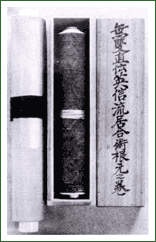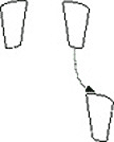 |
9, When bringing the Kissaki to the Koikuchi for
Noto, the blade must not travel in a circular motion. Just twist the right
hand wrist to the left.
Addition : To be able to do this, the right hand grip must be relaxed.
In the Seiza section, the moment the Kissaki meets with the Koikuchi,
or in Oku-Iai when two thirds of the blade has entered the Saya, movement
must be carried through without noticeable stoppage.
10, When performing Noto at the stage when the
Kissaki meets the Koikuchi the right hand should be lower than the Koikuchi.
Addition : This is a warning not to do Otoshi-zashi (Whilst doing Noto, bring the right hand above the head and drop the sword
into the Saya). Excluding Ryozume (Oku-Iai No 7). My teacher Yamamoto
Takuji always said that the Bushi had never used this action.
KONGEN no MAKI |
11, Noto action (Seiza section), pulling the foot backward
in a smooth movement. Until the other knee touches the ground the upper body
should be kept still.
 |
Addition : This is the advice given in pulling the foot back. To make
this action easier drop the hip a little as you pull the foot back (Iai-goshi)
Doing this, it is easier to keep the body steady.
12, Chinugui (taking off the blood) in Tsukekomi
(Seiza No 8). Whilst wiping off the blood with the left hand the hip must
not be pulled back. Addition : Forcing forward with the determination
keeps the general posture correct.
13, Oku Iai Noto; If the right hand is higher than
the Koikuchi at the outset, Drop the hand before the movement starts. |
Addition : This applies not only to Oku-Iai but to all other Noto forms. If
the right hand is higher, lower it smoothly and inconspicuously.
14, When performing Tsukekomi, Kaishaku and Iwanami the
right fist must not be lower than the Koikuchi. Also at this time the upper
body must not incline forwards.
Addition : When doing these three forms, Waist and abdominal power must be
firmly maintained.
15, Kamae in Kaishaku ; The blade inclines a little
backward rather than upright.
Addition : The style, method, and Kamae etc. was specific to individual Clans
(Han). The Kamae position can generally be explained as follows :
a, The blade is behind the shoulder.
b, The right fist is above the right shoulder.
c, The blade inclines to the left, Kissaki pointing to the left side of ones
own body. The points determined in Oh-e SenseiÕs Tuition are;
The difference in the Kirioroshi angle depends upon the angle of the head
of the person who is to be decapitated. The right hand must not be lower than
the target at the end of Kirioroshi. To be able to cut in a straight line, the
power of the right hand grip must be restrained at the beginning of the action.
If the grip is too strong the cutting curve will be restricted inhibiting an
accurate cut.
16, Furikaburi motion in Tsukekomi (Seiza No 9) must
be extensive before Kirioroshi action. However is this form Kirioroshi is completed
on the second cut. Therefore the first cut must be taken a little shallow, then
the second one deep.
Addition : Tsukekomi technique is used to avoid the opponents first cut cutting
back lightly to the his forehead. Consequently chasing the opponent to finish
him with a large Kirioroshi. In other words the Kirioroshi should be done fast
with short action, the second slow and full. The footwork for this second cut
must be extensive with Iai-goshi. Ma in between these cut is difficult to put
down in words. If it is too short it looks like the two movements are continuous.
Too long and it resembles late timing. As we always say Practice makes perfect.
17, Uchigoroshi in Ukigumo (Tatehiza No 4) is as follows;
a, The sword action finishes outside of the left leg.
b, The blade is parallel to this leg.
Addition : The aim of this action is to cut a fallen opponents body. An important
point of this action is to seize the Tsuka with both hands before doing Kirioroshi.
The method of seizing the Tsuka is used in very few forms of Muso Jikiden Eishin
Ryu.
18, uka-ate in Oroshi. (Tatehiza No 5). The left arm
must be fairly straight.
Addition : Tsuka-ate in Oroshi in Yuki-Chigai (standing Oku-Iai No 6). This
action is not just a thrust. It must be an amalgamated technique of thrusting
and striking. Both arms must be straightened.
19, In Uroko-gaeshi (Tatehiza No 7) and Nami-gaeshi
(Tatehiza No 8), both feet should be in the original position then, start to
draw the sword and pull the left foot backward at the same time.
Addition : In this case the body turns to the left in Iai-goshi, drawing out
the sword. This combination movement is very difficult to do. Try to draw the
sword out little by little turning the body naturally. To achieve this repeated
practice is essential.
20, When drawing the sword (Nukitsuke) in Kaishaku (Seiza
No 7) Tsukekomi (Seiza No 8) and Iwanami (Tatehiza No 7), the face must not
be averted down but face straight forward.
Addition : As stated in this section, The upper body must not lean forward.
Every technique has its own Metsuke to enable one to keep correct posture. Depending
on this Metsuke body posture differs. This is why the direction and height of
the Metsuke is very important.
21, When moving forward with the reversed right hand
in Kasumi (Iwaza Oku Iai No 1), the hip joint must not be twisted at any time.
Addition : This form must be performed in a straight upright body posture
with full waist and abdominal power pushing the body forward.
22, In Shiho-giri (Iwaza Oku Iai No 5) The Furikaburi
action should not be taken through the Uke-Nagashi movement.
Addition : First of all the Tsuki to the opponent left back. Then Kirioroshi
to the front right opponent. Kirioroshi to the left front opponent.
Finally Kirioroshi to the front opponent. When ones takes up Jodan-no- Kamae
to do the last Kirioroshi, it passes through Ukenagashi movement which covers
the shoulder with the sword.
23, In the case of Tana-shita (Iwaza Oku Iai No 6).
Because of limited space above the head; When taking Nukitsuke action, the face
must be perpendicular, looking straight forward with lower body movement.
Addition : Because of the narrow headroom the body is considerably bent. Moving
forward with a big movement of the right foot, the body is constricting and
uncomfortable. However this foot movement is to close the distance on the opponent.
This is why the face must be kept upright.
24, In Ryozume (Iwaza Oku Iai No 7) The Tsuki action
must be taken predominantly deep.
Addition : In this form it is not difficult to thrust deeply. As the space
between body and wall (fence) is very limited, Noto is not so easy without taking
Hanmi (diagonal posture).
25, Noto in Torabayashi (Iwaza Oku Iai No 8) and Soh-dome
(standing Oku Iai No 4) should be done as follows;
a, The blade is sheathed in the Saya in one singular action leaving only a
few inches between the Habaki and Koikuchi.
b, Complete Noto with strong Zanshin. Addition : Sheathing the last few inches
Noto should be completed carefully.
 |
Next page |

